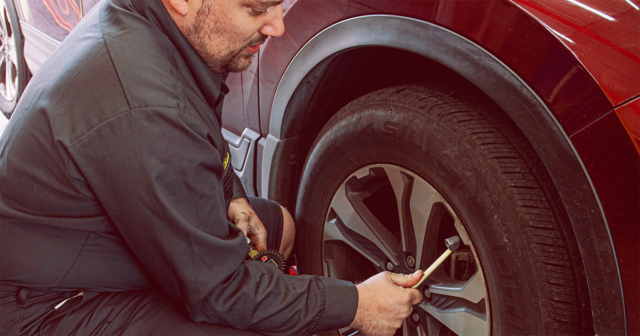Proper tire maintenance is crucial for vehicle safety, optimal performance, and extending the lifespan of your tires. By adopting regular tire maintenance practices, you can prevent unexpected tire failures and save on costs associated with premature tire replacement. Here are the essential tips for maintaining your tires, helping you get the most out of your investment, and keeping your vehicle running smoothly.
Maintaining Proper Tire Pressure
Keeping your tires at the correct pressure is one of the simplest yet most effective ways to extend their life. Underinflated or overinflated tires can lead to uneven wear, reduced fuel efficiency, and even potential blowouts.
- How to Check Tire Pressure: Use a reliable tire pressure gauge to check your tire pressure at least once a month and before long trips. Ensure the tires are “cold” or parked for three or more hours before measuring the tire pressure.
- Optimal Tire Pressure Levels: Refer to your vehicle’s manual or the sticker on the driver’s side door jamb for the recommended tire pressure levels.
- Impact of Overinflation and Underinflation: Overinflated tires can cause a harsh ride and uneven wear, while underinflated tires can lead to increased rolling resistance, overheating, and premature wear.
Wheel Alignment
Proper wheel alignment ensures your vehicle drives correctly and your tires wear evenly. Watch for signs such as uneven tire wear, your vehicle pulling to one side, or a crooked steering wheel. If you notice any of these signs, have your alignment checked by a professional technician at Kwik Kar. Correct alignment improves handling, increases tire lifespan, and maintains overall vehicle safety. Regular alignment checks, especially after hitting significant potholes or curbs, will ensure that your tires wear evenly, and your vehicle remains stable.
Balancing Tires
Balancing your tires helps distribute weight evenly, reducing vibrations and preventing uneven wear. Tire balancing involves adjusting the weight distribution around the tire and wheel assembly. Look out for vibrations in the steering wheel, seat, or floorboard at certain speeds, as these can be symptoms of unbalanced tires. It is advisable to have your tires balanced when you install new tires, after repairs, or if you experience vibrations.
Tire Rotation
Rotating your tires regularly promotes even wear across all four tires, enhancing their longevity and performance. It is recommended to get your tires rotated each time you come in for an oil change.
- Recommended Rotation Intervals: Most manufacturers recommend rotating your tires every 6,000 to 8,000 miles, or during every other oil change.
- Benefits of Tire Rotation: Regular rotation ensures that tires wear evenly, improving handling and extending tire lifespan.
- Different Tire Rotation Patterns: Depending on your vehicle and tire type, use appropriate rotation patterns such as front-to-back, cross, or 4-wheel drive patterns.
Driving Habits
Your driving habits can have a significant impact on tire wear. Hard braking, rapid acceleration, and sharp turns can accelerate tire wear. Practicing smooth driving habits, such as gradual acceleration and braking, can help extend tire life and improve fuel efficiency. Avoiding obstacles like potholes and curbs can prevent unnecessary damage to your tires. By adopting more mindful driving habits, you can significantly enhance the longevity of your tires.
Using Quality/New Tires
Quality tires offer better performance, durability, and safety features. When selecting new tires, consider factors such as tire type, size, and performance ratings. Consulting with our professionals at Kwik Kar can provide expert advice tailored to your specific vehicle needs. High-quality tires not only last longer but also contribute to better handling and overall driving experience.
Tread Depth Monitoring
Monitoring your tire tread depth is essential for maintaining traction and ensuring safety, especially in wet conditions.
- How to Measure Tread Depth: Use a tread depth gauge or the penny test – insert a penny into the tread with Lincoln’s head upside down. If you can see the top of Lincoln’s head, it is time to replace the tire.
- Minimum Safe Tread Depth: Replace tires when tread depth reaches 2/32 of an inch.
- Consequences of Worn-Out Tread: Worn-out tread can lead to reduced traction, increased stopping distances, and a higher risk of hydroplaning.
Regular Tire Maintenance Schedule
Keeping a regular tire maintenance schedule guarantees that all aspects for longer tire lifespan are monitored and addressed promptly. Consistent tire maintenance helps prevent unexpected issues, extends tire lifespan, and ensures safe driving conditions. Sticking to a routine tire maintenance schedule will guarantee your tires are always in optimal condition.

